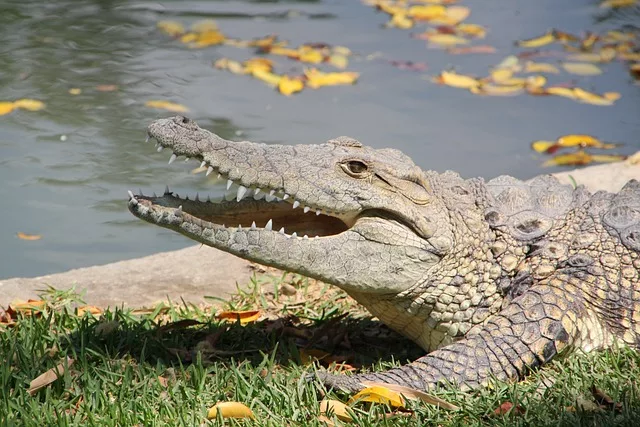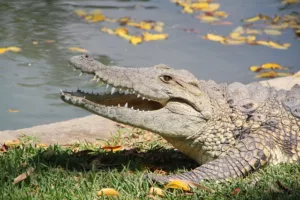Unraveling the Ancient Connection: Are Alligators Dinosaurs?
When it comes to the intriguing world of prehistoric creatures, the question often arises: Are alligators dinosaurs? This seemingly curious inquiry takes us on a journey through time, biology, and the fascinating evolutionary history of Earth’s inhabitants. In this article, we will explore the relationship between alligators and dinosaurs, shedding light on the connections that link these creatures separated by millions of years.
The Allure of Dinosaurs
Dinosaurs have long captured our imagination. These magnificent creatures ruled the Earth for millions of years, dominating the landscape with their colossal presence. The mere mention of the word “dinosaur” conjures up images of massive, fearsome reptiles that roamed the planet during the Mesozoic Era, which spanned from approximately 252 to 66 million years ago.
The Evolutionary Timeline
To understand the potential connection between alligators and dinosaurs, we must first delve into the evolutionary timeline. Dinosaurs are believed to have originated during the Late Triassic period, around 230 million years ago. Over the course of millions of years, they diversified into various species, including the iconic Tyrannosaurus rex and the gentle giant, Brachiosaurus.
The Mesozoic Epoch
The Mesozoic Era, often referred to as the “Age of Dinosaurs,” can be divided into three distinct periods: the Triassic, Jurassic, and Cretaceous. During this time, dinosaurs flourished, adapted to diverse ecosystems, and evolved into an astonishing array of forms, ranging from tiny feathered theropods to enormous, long-necked sauropods.
Alligators: Living Fossils?
Now that we’ve established the historical context, let’s turn our attention to alligators. Alligators, along with their close relatives, crocodiles, are members of the order Crocodylia. These remarkable creatures have a lineage that stretches back over 200 million years, which places them squarely within the Mesozoic Era alongside dinosaurs.
Ancestral Links
While alligators and dinosaurs are not direct descendants of one another, they share a common ancestor. This ancestor was a reptilian creature that lived during the Triassic period. Over time, this lineage split, with some descendants evolving into the diverse array of dinosaurs we know today, while others became the ancestors of modern crocodilians, including alligators.
Living Fossils
One of the most intriguing aspects of alligators is their status as “living fossils.” This term is often used to describe species that have changed very little over millions of years. Alligators, in many ways, resemble their ancient ancestors. Their basic body plan, lifestyle, and ecological niche have remained remarkably consistent throughout their long evolutionary history.
The Shared Characteristics of this question of “Are Alligators Dinosaurs”
To further explore the question of whether alligators can be considered a form of modern-day dinosaur, let’s examine some shared characteristics and distinctions.
Armor and Scales
Both dinosaurs and alligators sported tough, scaly exteriors. Dinosaurs had scales or feathers, depending on their species, while alligators are covered in sturdy, protective scales. These scales serve as armor against predators and environmental hazards.
Bipedal vs. Quadrupedal
One of the key distinctions between dinosaurs and alligators is their mode of movement. Dinosaurs, for the most part, were bipedal, walking on two legs. In contrast, alligators are quadrupedal, meaning they walk on all four legs. This fundamental difference in locomotion highlights the diversity of forms within the reptilian lineage.
Carnivorous Appetites
Both dinosaurs and alligators were carnivorous, although their diets varied. Dinosaurs evolved into a wide range of dietary niches, including herbivores, omnivores, and hypercarnivores. Alligators, on the other hand, are primarily carnivorous, feeding on fish, birds, mammals, and even other reptiles when the opportunity arises.
A Fascinating Evolutionary Journey
The story of alligators and dinosaurs takes us on a fascinating evolutionary journey. While alligators are not direct descendants of dinosaurs, they share a common ancestry and have maintained many primitive characteristics over millions of years.
The Survival of Alligators
The fact that alligators have survived for such an extended period underscores their remarkable adaptability. They have weathered mass extinctions, climate changes, and shifts in ecosystems. Today, they continue to thrive in wetlands, swamps, and rivers across the southeastern United States and beyond.
Lessons from the Past
The study of alligators and their connection to dinosaurs offers valuable insights into the persistence of life on Earth. It reminds us that some species, like alligators, have found successful survival strategies that have stood the test of time.
FAQ: Are Alligators Dinosaurs?
Are Alligators Related to Dinosaurs?
Alligators are not direct descendants of dinosaurs, but they share a common ancestry with them. They belong to the broader group of archosaurs, which includes dinosaurs and pterosaurs. Alligators have maintained primitive traits over millions of years, making them an interesting part of the reptilian evolutionary story.
Is a Crocodile Technically a Dinosaur?
No, a crocodile is not technically a dinosaur. Crocodiles, like alligators, belong to the order Crocodylia and share a common ancestry with dinosaurs. However, they are separate branches of the reptilian evolutionary tree and are not classified as dinosaurs.
What Is the Closest Living Thing to a Dinosaur?
Birds are considered the closest living relatives of dinosaurs. In fact, modern birds are descendants of small, feathered dinosaurs from the Theropod group. They share many characteristics with their dinosaur ancestors, including hollow bones and egg-laying.
What Dinosaurs Did Alligators Evolve From?
Alligators and dinosaurs share a common ancestor that lived during the Triassic period. While alligators did not directly evolve from specific dinosaur species, they branched off from this common reptilian ancestor and developed into the crocodilian lineage.
How Did Alligators Survive the Asteroid?
Alligators, along with many other species, survived the asteroid impact that led to the mass extinction of dinosaurs 66 million years ago. Their survival can be attributed to factors such as their ability to adapt to changing environments, their semiaquatic lifestyle, and the availability of suitable habitats during the post-impact period.
What Lived on Earth Before Dinosaurs?
Before the dominance of dinosaurs, Earth was inhabited by various forms of life, including early reptiles, amphibians, and primitive mammals. These pre-dinosaur creatures were part of the Triassic period, which marked the transition from the Paleozoic to the Mesozoic Era.
Has Dragons Ever Existed?
Dragons, as mythical creatures with fire-breathing abilities and fantastical characteristics, have never existed in reality. They are purely legendary and exist in the realm of folklore, mythology, and fantasy literature.
Were Humans Alive During Dinosaurs?
No, humans did not exist during the time of dinosaurs. The first anatomically modern humans, Homo sapiens, appeared much later in Earth’s history, approximately 200,000 years ago. Dinosaurs went extinct about 66 million years ago.
What Was the First Creature on Earth?
Determining the “first” creature on Earth is challenging, as life on our planet originated billions of years ago. The earliest life forms were likely simple, single-celled microorganisms such as bacteria and archaea. These microscopic organisms represent some of the earliest evidence of life on Earth.
Who Is the First Human in the World?
The concept of the “first human” is typically associated with the emergence of Homo sapiens, our own species. While there were earlier hominin species that preceded us in human evolution, Homo sapiens is considered the first and only surviving species within the Homo genus.
How Did Life Begin on Earth?
The exact origin of life on Earth remains a topic of scientific investigation and debate. The prevailing hypothesis is that life emerged from simple organic molecules in a primordial soup of Earth’s early oceans, possibly sparked by lightning, volcanic activity, or hydrothermal vents.
Where Was the First Human on Earth?
The first humans, Homo sapiens, likely originated in Africa. Fossil and genetic evidence supports the idea that our species evolved in Africa and later migrated to other parts of the world.
What Would Humans Look Like in 1,000 Years?
Predicting the exact appearance of humans in the future is speculative. Evolution occurs over extremely long periods, and environmental factors play a significant role in shaping physical characteristics. Changes in diet, technology, and other aspects of life could influence future human traits.
What Is the Oldest Race in the World?
The concept of “race” in the context of human populations is a social construct and not a biological category. There is no scientifically established “oldest race” in the world. Human genetic diversity is the result of various migrations and adaptations over thousands of years.
Who Was First, Adam or Eve?
Adam and Eve are figures from religious narratives, particularly in Christianity and Judaism. They are not historical or scientific figures, so the question of who came first is a matter of faith and theology, rather than a subject of scientific inquiry.
What Killed the Dinosaurs?
The most widely accepted theory for the mass extinction of dinosaurs is the impact hypothesis. It suggests that a large asteroid or comet impact, around 66 million years ago, caused massive fires, a “nuclear winter” effect, and catastrophic environmental changes that led to the extinction of most dinosaur species.
Why Did Dinosaurs Shrink?
The phenomenon of smaller dinosaurs evolving from larger ones, known as dwarfism, occurred in some dinosaur lineages. This could have been influenced by various factors, including changes in environmental conditions, resource availability, and evolutionary pressures.
Is a Turtle a Dinosaur?
No, a turtle is not a dinosaur. Turtles belong to a distinct group of reptiles called Testudines. While they coexisted with dinosaurs, turtles have a unique and separate evolutionary lineage.
What Dinosaur Is Closest to an Alligator?
Among dinosaurs, theropods share some similarities with modern alligators. Some theropods, like the Tyrannosaurus rex, belonged to the same group, known as the Archosauria, as modern alligators. However, alligators are not direct descendants of any specific dinosaur species.
Do Crocodiles Share DNA with Dinosaurs?
Yes, crocodiles share DNA with dinosaurs. Both crocodiles and dinosaurs belong to the broader group of archosaurs, and they share a common ancestor from the distant past. This genetic connection highlights their evolutionary relationship.
Are Komodo Dragons Dinosaurs?
No, Komodo dragons are not dinosaurs. They are modern-day reptiles belonging to the monitor lizard family, Varanidae. Dinosaurs are a separate group of reptiles that went extinct millions of years ago.
Are Alligators Evolving?
Yes, like all living species, alligators continue to undergo evolutionary changes over long periods of time. Evolution is an ongoing process driven by genetic mutations and natural selection. Alligators adapt to changing environments and ecological pressures through this process.
What Dinosaurs Aren’t Dinosaurs?
Not all creatures that people commonly refer to as “dinosaurs” belong to the dinosaur group scientifically. Pterosaurs, ichthyosaurs, and plesiosaurs, for example, are often confused with dinosaurs, but they belong to different reptilian lineages.
Did Crocodiles Exist When Dinosaurs Existed?
Yes, crocodiles are ancient reptiles that coexisted with dinosaurs during the Mesozoic Era. Crocodiles, like dinosaurs, are part of the archosaur lineage, and their history dates back to the Triassic period, long before the extinction of dinosaurs.
Conclusion: Are Alligators Dinosaurs?
In conclusion, while alligators are not technically classified as dinosaurs, they are part of the broader evolutionary story of reptiles. They share a common ancestry with dinosaurs and have maintained many primitive traits throughout their long history. Alligators are living relics of an ancient era, providing us with a glimpse into the world that once belonged to dinosaurs.
So, are alligators dinosaurs? Not in the strict taxonomic sense, but they are undoubtedly fascinating creatures with a rich evolutionary history. Their existence today serves as a living testament to the enduring legacy of Earth’s prehistoric past.
In our exploration of this intriguing question, we are reminded of the complexity of life on our planet and the remarkable journeys of adaptation and survival that various species have undertaken. The world of paleontology continues to unveil new discoveries, shedding light on the intricate web of life’s history, both past and present.

